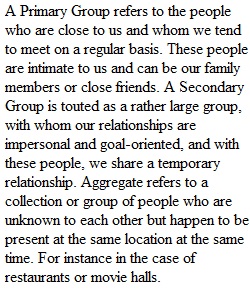


Q Module Two-Assignment Two-Field Observation Due Nov 20 by 11:59pm Points 100 Submitting a text entry box, a website url, a media recording, or a file upload Fieldwork—Observation(s) of Social Life- Assignment Two: 100 points possible. View this video: Link (Links to an external site.) The terminology and key concepts found in chapters three through seven are the building blocks for the discipline. Module two centers on these fundamental principles. In every social setting folkways are present. Discussion Three is about breaches or norm violations. Read and respond to the observations in this discussion, before completing Assignment Two. A copy of your discussion contributions is required with Assignment Two. Discussion Three-Field Observations and Norm Breaching Tasks: In a Word Document, complete four field observations. Provide examples of terms or concepts in these observations based on textbook and road map material. Complete an observation for each of the four categories. Define the terms and concepts and observe the social settings: Primary Group (family, close friends) Secondary Group (school, work or team sport) Aggregate (public setting like on the Strip) Norm violation or breaching experience (Norm breached, Value represented, Sanction observed). Answer the following for each of the settings: Definitions for the terms discussed. Such as primary group. A description of the social setting (size, statuses, roles etc.). Address any ethical consoderations. Example of a concept from the text material that you noted. (hierarchy, gender, socialization and so forth). What folkways did you observe? (Standing in line, washing hands, walking on the right) Discuss the value represented by the norm (the line establishes a value of fairness). Describe any breaches and sanctions observed (someone took cuts or let others in front of them). Provide evidence of attendance (a selfie, picture of a menu, ticket stub, video or flyer for the event) be creative. Images can be placed in the Word Document. Attach a copy of Discussion Three contributions. Separate documents should be titled and posted as “resubmit” in the Canvas assignment portal. Some appropriate terms useful in this assignment include: Useful link for concepts worth to consider: Link (Links to an external site.) Roles, statuses, status set, folkways, mores, aggregate, primary, groups, secondary group, dyad, triad, coalitions, socialization, media representations, gender roles, hierarchy, social class, values, value clusters, cultural lag, deviance, master status, reference group, subculture, counter culture, labeling theory, differential association theory and the like. HINDSIGHT 2020: While observing social structures, please begin to ask those around you how the pandemic impacted them, what they think is the best attitude forward and lessons learned through these anomic times. Anomie: a state of social and moral disorder; normlesslessness.
View Related Questions